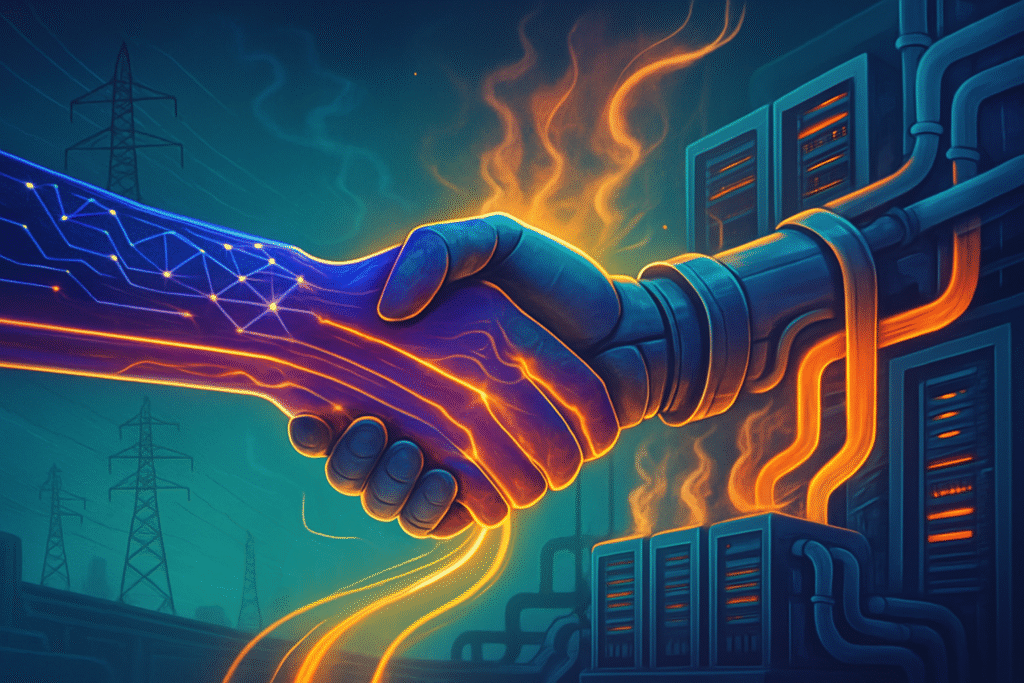
In a landmark strategic cooperation agreement, OpenAI and Japanese industrial giant Hitachi (TSE: 6501) have joined forces to tackle one of the most pressing challenges facing the burgeoning artificial intelligence industry: the immense power and cooling demands of AI data centers. Announced around October 2nd or 3rd, 2025, this partnership is set to develop and implement advanced, energy-efficient solutions crucial for scaling OpenAI's generative AI models and supporting its ambitious global infrastructure expansion, including the multi-billion dollar "Stargate" project.
The immediate significance of this collaboration cannot be overstated. As generative AI models continue to grow in complexity and capability, their computational requirements translate directly into unprecedented energy consumption and heat generation. This alliance directly addresses these escalating demands, aiming to overcome a critical bottleneck in the sustainable growth and widespread deployment of AI technologies. By combining OpenAI's cutting-edge AI advancements with Hitachi's deep industrial expertise in energy, power grids, and cooling, the partnership signals a crucial step towards building a more robust, efficient, and environmentally responsible foundation for the future of artificial intelligence.
Technical Foundations for a New Era of AI Infrastructure
The strategic cooperation agreement between OpenAI and Hitachi (TSE: 6501) is rooted in addressing the fundamental physical constraints of advanced AI. Hitachi's contributions are centered on supplying essential infrastructure for OpenAI's rapidly expanding data centers. This includes providing robust power transmission and distribution equipment, such as high-efficiency transformers, vital for managing the colossal and often fluctuating electricity loads of AI workloads. Crucially, Hitachi will also deploy its advanced air conditioning and cooling technologies. While specific blueprints are still emerging, it is highly anticipated that these solutions will heavily feature liquid cooling methods, such as direct-to-chip or immersion cooling, building upon Hitachi's existing portfolio of pure water cooling systems.
These envisioned solutions represent a significant departure from traditional data center paradigms. Current data centers predominantly rely on air cooling, a method that is becoming increasingly insufficient for the extreme power densities generated by modern AI hardware. AI server racks, projected to reach 50 kW or even 100 kW by 2027, generate heat that air cooling struggles to dissipate efficiently. Liquid cooling, by contrast, can remove heat directly from components like Graphics Processing Units (GPUs) and Central Processing Units (CPUs), offering up to a 30% reduction in energy consumption for cooling, improved performance, and a smaller physical footprint for high-density environments. Furthermore, the partnership emphasizes the integration of renewable energy sources and smart grid technologies, moving beyond conventional fossil fuel reliance to mitigate the substantial carbon footprint of AI. Hitachi's Lumada digital platform will also play a role, with OpenAI's large language models (LLMs) potentially being integrated to optimize energy usage and data center operations through AI-driven predictive analytics and real-time monitoring.
The necessity for such advanced infrastructure stems directly from the extraordinary computational demands of modern AI, particularly large language models (LLMs). Training and operating these models require immense amounts of electricity; a single large AI model can consume energy equivalent to 120 U.S. homes in a year. For instance, OpenAI's GPT-3 consumed an estimated 284,000 kWh during training, with subsequent models like GPT-4 being even more power-hungry. This intense processing generates substantial heat, which, if not managed, can lead to hardware degradation and system failures. Beyond power and cooling, LLMs demand vast memory and storage, often exceeding single accelerator capacities, and require high-bandwidth, low-latency networks for distributed processing. The ability to scale these resources reliably and efficiently is paramount, making robust power and cooling solutions the bedrock of future AI innovation.
Reshaping the AI Competitive Landscape
The strategic alliance between OpenAI and Hitachi (TSE: 6501) is set to send ripples across the AI industry, impacting tech giants, specialized AI labs, and startups alike. OpenAI, at the forefront of generative AI, stands to gain immensely from Hitachi's deep expertise in industrial infrastructure, securing the stable, energy-efficient data center foundations critical for scaling its operations and realizing ambitious projects like "Stargate." This partnership also provides a significant channel for OpenAI to deploy its LLMs into high-value, real-world industrial applications through Hitachi's well-established Lumada platform.
Hitachi, in turn, gains direct access to OpenAI's cutting-edge generative AI models, which will significantly enhance its Lumada digital transformation support business across sectors like energy, mobility, and manufacturing. This strengthens Hitachi's position as a provider of advanced, AI-driven industrial and social infrastructure solutions. Indirectly, Microsoft (NASDAQ: MSFT), a major investor in OpenAI and a strategic partner of Hitachi, also benefits. Hitachi's broader commitment to integrating OpenAI's technology, often via Azure OpenAI Service, reinforces Microsoft's ecosystem and its strategic advantage in providing enterprise-grade AI cloud services. Companies specializing in industrial IoT, smart infrastructure, and green AI technologies are also poised to benefit from the intensified focus on energy efficiency and AI integration.
The competitive implications for major AI labs like Google DeepMind (NASDAQ: GOOGL), Anthropic, and Meta AI (NASDAQ: META) are substantial. This partnership solidifies OpenAI's enterprise market penetration, particularly in industrial sectors, intensifying the race for enterprise AI adoption. It also underscores a trend towards consolidation around major generative AI platforms, making it challenging for smaller LLM providers to gain traction without aligning with established tech or industrial players. The necessity of combining advanced AI models with robust, energy-efficient infrastructure highlights a shift towards "full-stack" AI solutions, where companies offering both software and hardware/infrastructure capabilities will hold a significant competitive edge. This could disrupt traditional data center energy solution providers, driving rapid innovation towards more sustainable and efficient technologies. Furthermore, integrating LLMs into industrial platforms like Lumada is poised to create a new generation of intelligent industrial applications, potentially disrupting existing industrial software and automation systems that lack advanced generative AI capabilities.
A Broader Vision for Sustainable AI
The OpenAI-Hitachi (TSE: 6501) agreement is more than just a business deal; it's a pivotal moment reflecting critical trends in the broader AI landscape. It underscores the global race to build massive AI data centers, a race where the sheer scale of computational demand necessitates unprecedented levels of investment and multi-company collaboration. As part of OpenAI's estimated $500 billion "Stargate" project, which involves other major players like SoftBank Group (TYO: 9984), Oracle (NYSE: ORCL), NVIDIA (NASDAQ: NVDA), Samsung (KRX: 005930), and SK Hynix (KRX: 000660), this partnership signals that the future of AI infrastructure requires a collective, planetary-scale effort.
Its impact on AI scalability is profound. By ensuring a stable and energy-efficient power supply and advanced cooling, Hitachi directly alleviates bottlenecks that could otherwise hinder the expansion of OpenAI's computing capacity. This allows for the training of larger, more complex models and broader deployment to a growing user base, accelerating the pursuit of Artificial General Intelligence (AGI). This focus on "greener AI" is particularly critical given the environmental concerns surrounding AI's exponential growth. Data centers, even before the generative AI boom, contributed significantly to global greenhouse gas emissions, with a single model like GPT-3 having a daily carbon footprint equivalent to several tons of CO2. The partnership's emphasis on energy-saving technologies and renewable energy integration is a proactive step to mitigate these environmental impacts, making sustainability a core design principle for next-generation AI infrastructure.
Comparing this to previous AI milestones reveals a significant evolution. Early AI relied on rudimentary mainframes, followed by the GPU revolution and cloud computing, which primarily focused on maximizing raw computational throughput. The OpenAI-Hitachi agreement marks a new phase, moving beyond just raw power to a holistic view of AI infrastructure. It's not merely about building bigger data centers, but about building smarter, more sustainable, and more resilient ones. This collaboration acknowledges that specialized industrial expertise in energy management and cooling is as vital as chip design or software algorithms. It directly addresses the imminent energy bottleneck, distinguishing itself from past breakthroughs by focusing on how to power that processing sustainably and at an immense scale, thereby positioning itself as a crucial development in the maturation of AI infrastructure.
The Horizon: Smart Grids, Physical AI, and Unprecedented Scale
The OpenAI-Hitachi (TSE: 6501) partnership sets the stage for significant near-term and long-term developments in AI data center infrastructure and industrial applications. In the near term, the immediate focus will be on the deployment of Hitachi's advanced cooling and power distribution systems to enhance the energy efficiency and stability of OpenAI's data centers. Simultaneously, the integration of OpenAI's LLMs into Hitachi's Lumada platform will accelerate, yielding early applications in industrial digital transformation.
Looking ahead, the long-term impact involves a deeper integration of energy-saving technologies across global AI infrastructure, with Hitachi potentially expanding its role to other critical data center components. This collaboration is a cornerstone of OpenAI's "Stargate" project, hinting at a future where AI data centers are not just massive but also meticulously optimized for sustainability. The synergy will unlock a wide array of applications: from enhanced AI model development with reduced operational costs for OpenAI, to secure communication, optimized workflows, predictive maintenance in sectors like rail, and accelerated software development within Hitachi's Lumada ecosystem. Furthermore, Hitachi's parallel partnership with NVIDIA (NASDAQ: NVDA) to build a "Global AI Factory" for "Physical AI"—AI systems that intelligently interact with and optimize the real world—will likely see OpenAI's models integrated into digital twin simulations and autonomous industrial systems.
Despite the immense potential, significant challenges remain. The extreme power density and heat generation of AI hardware are straining utility grids and demanding a rapid, widespread adoption of advanced liquid cooling technologies. Scaling AI infrastructure requires colossal capital investment, along with addressing supply chain vulnerabilities and critical workforce shortages in data center operations. Experts predict a transformative period, with the AI data center market projected to grow at a 28.3% CAGR through 2030, and one-third of global data center capacity expected to be dedicated to AI by 2025. This will necessitate widespread liquid cooling, sustainability-driven innovation leveraging AI itself for efficiency, and a trend towards decentralized and on-site power generation to manage fluctuating AI loads. The OpenAI-Hitachi partnership exemplifies this future: a collaborative effort to build a resilient, efficient, and sustainable foundation for AI at an unprecedented scale.
A New Blueprint for AI's Future
The strategic cooperation agreement between OpenAI and Hitachi (TSE: 6501) represents a pivotal moment in the evolution of artificial intelligence, underscoring a critical shift in how the industry approaches its foundational infrastructure. This partnership is a clear acknowledgment that the future of advanced AI, with its insatiable demand for computational power, is inextricably linked to robust, energy-efficient, and sustainable physical infrastructure.
The key takeaways are clear: Hitachi will provide essential power and cooling solutions to OpenAI's data centers, directly addressing the escalating energy consumption and heat generation of generative AI. In return, OpenAI's large language models will enhance Hitachi's Lumada platform, driving industrial digital transformation. This collaboration, announced around October 2nd or 3rd, 2025, is a crucial component of OpenAI's ambitious "Stargate" project, signaling a global race to build next-generation AI infrastructure with sustainability at its core.
In the annals of AI history, this agreement stands out not just for its scale but for its integrated approach. Unlike previous milestones that focused solely on algorithmic breakthroughs or raw computational power, this partnership champions a holistic vision where specialized industrial expertise in energy management and cooling is as vital as the AI models themselves. It sets a new precedent for tackling AI's environmental footprint proactively, potentially serving as a blueprint for future collaborations between AI innovators and industrial giants worldwide.
The long-term impact could be transformative, leading to a new era of "greener AI" and accelerating the penetration of generative AI into traditional industrial sectors. As AI continues its rapid ascent, the OpenAI-Hitachi alliance offers a compelling model for sustainable growth and a powerful synergy between cutting-edge digital intelligence and robust physical infrastructure. In the coming weeks and months, industry observers should watch for detailed project rollouts, performance metrics on energy efficiency, new Lumada integrations leveraging OpenAI's LLMs, and any further developments surrounding the broader "Stargate" initiative, all of which will provide crucial insights into the unfolding future of AI.
This content is intended for informational purposes only and represents analysis of current AI developments.
TokenRing AI delivers enterprise-grade solutions for multi-agent AI workflow orchestration, AI-powered development tools, and seamless remote collaboration platforms.
For more information, visit https://www.tokenring.ai/.






